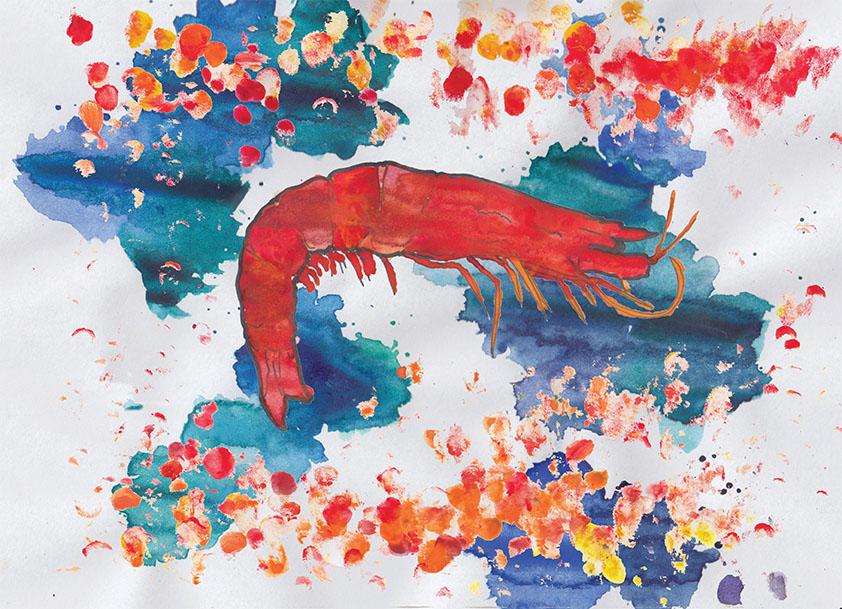Skimp on Shrimp
January 6, 2017
It’s a warm, sunny afternoon and you’re touring the aisles at Whole Foods. You scan for the perfect thing to make for your dinner party. You pick up some garlic, parsley, and lemons to season your meal before it is dipped in cocktail sauce. Then, you wait in line and purchase one pound of shrimp. Unbeknownst to you, that one pound of shrimp cost much more than the $13.99 you paid.
Farmed Shrimp
Shrimp farming is a major cause of environmental degradation. 95 percent of all shrimp consumed is farm raised.
Shrimp farming is conducted in small pools of water hollowed out from nutrient rich mangrove stands. Mangroves are trees with large roots that grow out of the ocean on shallow sand banks. To have a large pond for shrimp, the mangroves must be stripped from the area. The mangroves’ twisting roots provide shelter and nutrients for wild shrimp and other aquatic animals.
In Thailand, the third largest global shrimp exporter, farmers are seeing the effects of their stripping. When the mangroves were torn out, the locals who relied on catching wild sea animals for food and profit found themselves with a problem.
But diminishing populations and destroyed habitats don’t affect only fishermen. The mangroves, besides being nurseries for fish, provide a buffer for local villages against flooding. In the 2004 tsunami, coastal areas with thriving mangrove populations experienced less damage than communities that had destroyed their groves.
Health Risks
Another problem with shrimp farming, is that areas with mangrove stands are only nutrient rich because of the mangroves. When the mangroves are removed, the process of filtering water and pumping nutrients and oxygen back into the soil has to be simulated by fertilizers and antibiotics.
Shrimp catch diseases much more easily in isolated ponds. Because of this, farmed shrimp pose certain health risks to us.
Farmed shrimp is often grown in developing countries where antibiotics are not regulated.
Some of the chemicals used in these ponds include Organophosphates, Malachite Green, and Rotenone. All three of these chemicals have been proven to negatively affect humans.
According to the Mt. Sinai Journal of Medicine, Organophosphates, used for shrimp disease treatment, are linked to toxicity in pregnant women, and Malachite Green, used as an anti-fungal on shrimp eggs, has been shown to create cancerous tumors on mice.
Rotenone is used to in shrimp farming to kill off the existing fish in the human made ponds. Besides killing fish, Rotenone can create Parkinson’s symptoms in mice, and, when inhaled by humans, causes respiratory paralysis.
The FDA found that 25 percent of shrimp contain illegal medications.
In addition, Ready-to-Eat shrimp, because of all the medications introduced in shrimp ponds, have 162 separate varieties of antibiotic resistant bacteria.
Shrimp cleaning processes are also extremely unsanitary. According to Food & Water Watch, shrimp is responsible for 26 to 35 percent of all rejected imported seafood.
In developing countries, shrimp is either left to sit in unregulated temperatures or frozen in contaminated water, both of which expose the shrimp to bacterial contamination.
The factories used to clean shrimp, are often dirty. There are reports of a shrimp cleaning facility in Vietnam with floors littered with garbage and flies and insects buzzing all around.
The FDA rejected 1,380 loads of seafood from Vietnam alone in the past nine years.
Wild-Caught Shrimp
You must be thinking, “Then I’ll just buy the wild-caught shrimp that Whole Foods offers.”
But wild-caught shrimp is the largest known source of bycatch, which is the name coined to represent the billions of animals, unwanted or unsellable, wasted during the fishing for a different species.
According to the Food and Agriculture Association of the United Nations, shrimp is responsible for 35 percent of global commercial bycatch.
And, in agreement with these statistics, Seafood Watch states that for the pound of shrimp you bought, up to six pounds of bycatch were caught as well. That’s six pounds of turtles, dolphins and baby whales dying for just one pound of shrimp.
Maybe to you shrimp is so important that you don’t care, but keep this in mind: Oceana found through DNA testing that 25 percent of shrimp labeled “wild-caught” were in fact farm raised.
No matter how you look at it, eating shrimp is just plain old bad: bad for you, bad for your dinner party guests, bad for the environment, and bad for the fish in the sea. For some people shrimp is an important staple, but we all have to take a step back from the seafood counter and choose not to buy the pound of shrimp. It’s not a matter of political views, it’s a mater of health: personal and planetary.
Student Voices
Junior Sasha Hsu
“Prior to reading Skimp on Shrimp, my knowledge on the consequences of shrimp farming was quite basic, and I did not understand many of the externalities that arrive with the process.
“Personally, I enjoy eating shrimp, but now that I understand how detrimental it is to the environment (more specifically a rare wonder of the world like the mangroves) my view on eating shrimp has been altered.
“Hopefully, in the future, a new form of shrimp farming that is less harmful to the environment can make eating shrimp fine, but for now, it is important to hold and share the knowledge of these dangers because, in the simplest form, if you eat shrimp, you are supporting the farming and, more importantly, the destruction of an ecosystem that is responsible for the health of nature and many species, including humans.”
Sophomore Alex Koke
“Before this article, I didn’t have much knowledge about the shrimp farming industry. I wasn’t aware of the effects it has on the environment and the ecosystems of the ocean.
“This article has given me knowledge on the subject and I am now conscious of the grave effects shrimp farming has. It makes me think twice about where my shrimp comes from and whether or not I should consume it.
“This is a dilemma that will not be easy to solve but hopefully the fish farming industry will realize the damage it is causing to the environment and try to change its harmful ways. “


































